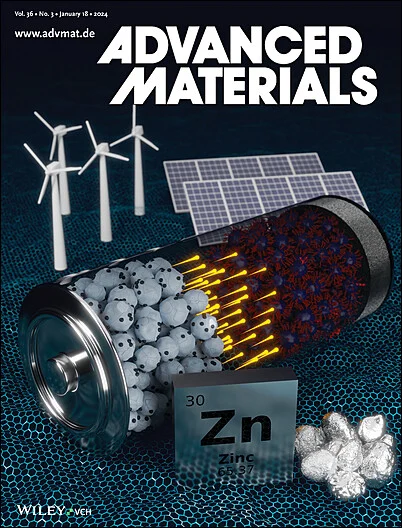掺碘钒酸钠阴极改善锌离子扩散动力学
IF 26.8
1区 材料科学
Q1 CHEMISTRY, MULTIDISCIPLINARY
引用次数: 0
摘要
锌离子与主体结构之间的静电相互作用极大地限制了钒基阴极在水性锌离子电池(AZIBs)中的实用性。本文证明了阴离子掺杂策略通过将碘原子掺入正极材料Na2V6O16·3H2O的晶格中来减轻锌离子插入时的静电阻力和位阻。碘掺杂降低了最稳定位点的吸附能,从而减弱了Zn2+与宿主的相互作用,降低了Zn2+的扩散能垒,导致扩散系数提高了一个数量级。此外,碘的大原子尺寸扩大了主体晶格,为增加锌离子的存储容量创造了充足的空间,引入的氧空位进一步支持了这一点。结果表明,在0.5 a g−1电流密度下,掺碘的Na2V6O16·3H2O阴极的比容量达到528.8 mAh g−1,在10 a g−1的高电流密度下,在12000次循环后仍保持262 mAh g−1。这项工作为azib高性能正极材料的设计提供了新的见解。本文章由计算机程序翻译,如有差异,请以英文原文为准。

Iodine-Doped Sodium Vanadate Cathode for Improved Zn Ion Diffusion Kinetics
The electrostatic interaction between zinc ions and the host structure significantly limits the practicality of vanadium-based cathodes in aqueous zinc-ion batteries (AZIBs). Herein, an anion doping strategy is demonstrated to mitigate electrostatic resistance and steric hindrance during zinc ion insertion by incorporating iodine atoms into the lattice of the cathode material, Na2V6O16·3H2O. Iodine doping reduces the adsorption energy at the most stable site, thereby weakening the Zn2+-host interaction and lowering the Zn2+ diffusion energy barrier, resulting in a one-order-of-magnitude increase in the diffusion coefficient. Moreover, the large atomic size of iodine expands the host lattice, creating ample space for increased zinc ion storage capacity, further supported by the introduced oxygen vacancies. As a result, the iodine-doped Na2V6O16·3H2O cathode achieves an impressive specific capacity of 528.8 mAh g−1 at a current density of 0.5 A g−1, and retains 262 mAh g−1 after 12,000 cycles at a high current rate of 10 A g−1. This work provides new insights into the design of high-performance cathode materials for AZIBs.
求助全文
通过发布文献求助,成功后即可免费获取论文全文。
去求助
来源期刊

Advanced Materials
工程技术-材料科学:综合
CiteScore
43.00
自引率
4.10%
发文量
2182
审稿时长
2 months
期刊介绍:
Advanced Materials, one of the world's most prestigious journals and the foundation of the Advanced portfolio, is the home of choice for best-in-class materials science for more than 30 years. Following this fast-growing and interdisciplinary field, we are considering and publishing the most important discoveries on any and all materials from materials scientists, chemists, physicists, engineers as well as health and life scientists and bringing you the latest results and trends in modern materials-related research every week.
 求助内容:
求助内容: 应助结果提醒方式:
应助结果提醒方式:


